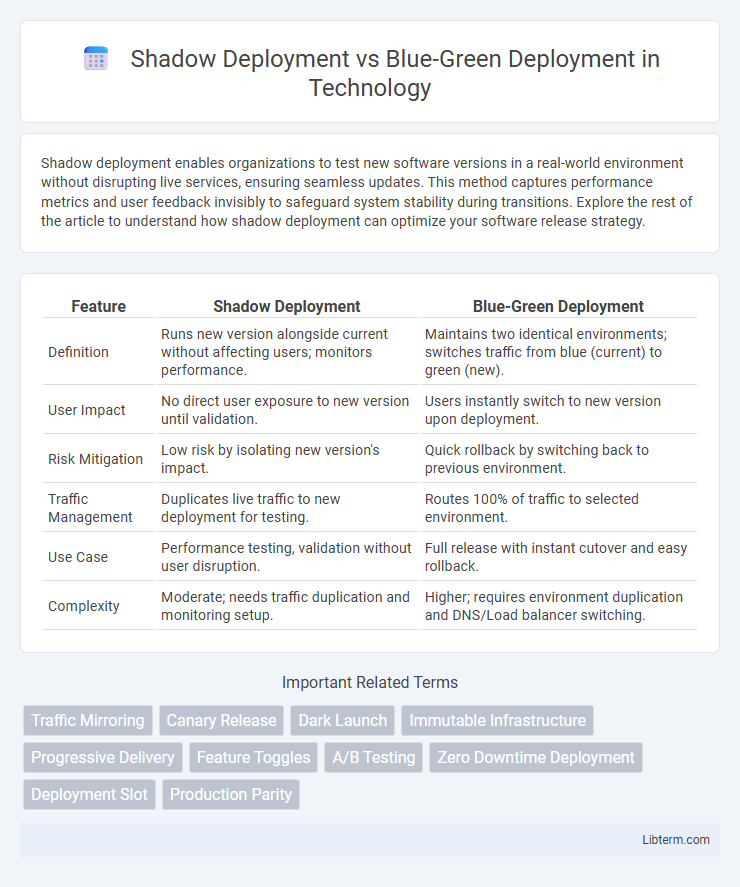Shadow deployment enables organizations to test new software versions in a real-world environment without disrupting live services, ensuring seamless updates. This method captures performance metrics and user feedback invisibly to safeguard system stability during transitions. Explore the rest of the article to understand how shadow deployment can optimize your software release strategy.
Table of Comparison
| Feature | Shadow Deployment | Blue-Green Deployment |
|---|---|---|
| Definition | Runs new version alongside current without affecting users; monitors performance. | Maintains two identical environments; switches traffic from blue (current) to green (new). |
| User Impact | No direct user exposure to new version until validation. | Users instantly switch to new version upon deployment. |
| Risk Mitigation | Low risk by isolating new version's impact. | Quick rollback by switching back to previous environment. |
| Traffic Management | Duplicates live traffic to new deployment for testing. | Routes 100% of traffic to selected environment. |
| Use Case | Performance testing, validation without user disruption. | Full release with instant cutover and easy rollback. |
| Complexity | Moderate; needs traffic duplication and monitoring setup. | Higher; requires environment duplication and DNS/Load balancer switching. |
Introduction to Deployment Strategies
Shadow deployment involves releasing a new version of software alongside the existing one without affecting live traffic, enabling real-time testing and validation. Blue-green deployment uses two identical environments, switching user traffic from the old (blue) to the new (green) version instantly, ensuring zero downtime. Both strategies aim to minimize risk and improve deployment reliability by isolating new releases from active systems during testing.
What is Shadow Deployment?
Shadow Deployment is a software release strategy where new code runs alongside the current production environment without affecting live user traffic, allowing performance and behavior monitoring under real-world conditions. This approach helps detect potential issues and validate new features by mirroring incoming requests to the shadow version while users continue interacting with the stable version. It reduces risk and enables safer testing compared to Blue-Green Deployment, which switches traffic entirely between two distinct environments.
What is Blue-Green Deployment?
Blue-Green Deployment is a release management strategy that reduces downtime and risk by maintaining two identical production environments called "Blue" and "Green." The new version of the application is deployed to the inactive environment, and after thorough testing, traffic is switched from the active environment to the updated one. This method ensures seamless user experience and quick rollback capabilities if issues arise.
Key Differences Between Shadow and Blue-Green Deployment
Shadow Deployment routes real user traffic to a new version of the application in parallel while keeping the production environment unchanged, allowing performance comparison without impacting users. Blue-Green Deployment switches all traffic instantly from the old version (Blue) to the new version (Green), minimizing downtime but requiring full deployment validation beforehand. Shadow Deployment is ideal for testing under real traffic conditions without risk, whereas Blue-Green Deployment emphasizes rapid rollback and zero downtime during release.
Benefits of Shadow Deployment
Shadow deployment enables the seamless testing of new software versions in a real-time production environment without impacting end users, enhancing reliability and minimizing risk. It provides comprehensive performance insights and error detection under authentic workload conditions, driving data-driven improvements. This approach ensures continuous delivery with zero downtime, facilitating smoother, safer transitions during software updates.
Benefits of Blue-Green Deployment
Blue-Green Deployment minimizes downtime and risk by maintaining two identical production environments, allowing seamless traffic switching between the stable Blue environment and the new Green version. This strategy enhances rollback capabilities with immediate recovery to the previous stable version in case of issues, ensuring continuous availability and reliability. It supports thorough testing in the Green environment without affecting the live Blue environment, improving deployment confidence and user experience.
Use Cases for Shadow Deployment
Shadow deployment is ideal for testing new features or infrastructure changes in production without impacting live traffic, enabling risk-free validation and performance monitoring. It suits scenarios where thorough evaluation against real user behavior is critical, such as load testing or A/B testing complex algorithms. Enterprises use shadow deployment to gain actionable insights and detect potential issues early before full-scale rollout.
Use Cases for Blue-Green Deployment
Blue-Green Deployment is ideal for applications requiring zero downtime upgrades and immediate rollback capabilities, such as e-commerce platforms and financial services where uninterrupted user experience is critical. It enables production traffic to seamlessly switch between two identical environments, allowing thorough testing of new versions without impacting current users. Enterprises benefit from Blue-Green Deployment in scenarios demanding instant failure recovery, minimizing risk and maintaining high availability.
Challenges and Limitations of Each Strategy
Shadow deployment faces challenges with increased resource consumption and the complexity of maintaining parallel environments without exposing untested features to users, leading to potential synchronization issues. Blue-Green deployment is limited by the requirement for duplicate infrastructure, which can be costly and inefficient, and carries the risk of user session disruptions during the switch between environments. Both strategies demand robust monitoring and rollback mechanisms to address deployment failures promptly and maintain system stability.
Choosing the Right Deployment Approach for Your Needs
Choosing between Shadow Deployment and Blue-Green Deployment depends on application complexity and risk tolerance. Shadow Deployment enables testing new versions in parallel without impacting live traffic, ideal for validating features under real conditions. Blue-Green Deployment offers rapid rollback and zero downtime by switching traffic between identical environments, suited for critical systems requiring high availability.
Shadow Deployment Infographic

 libterm.com
libterm.com